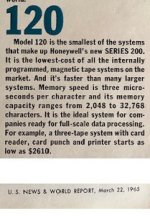RobS
Experienced Member
I see your point Dwight but these boards drive the lights on the panel which are continuously flashing along with the data stream, so there is no need for them to latch anything. To prevent permanent latching there has to be, as you say, a current source that is continuously pulsing so why not just use an AC source to achieve that? The result would have been that the lights could be powered by just a suitable transformer without the need for a DC PSU, which in the 1960s would not have been a simple device. I estimate that all the lights in the control panel would collectively draw seven amps at fourteen volts, which is say a hundred watts. Why bother with a hundred watt DC PSU when just a transformer would suffice? I am guessing of course but a key aspect of my project, arising from the fact that I don't have a detailed specification of the circuits in the original machine and am having to rework the design myself, is that I am getting an insight into the problems that the original designers faced, especially because I am restricting myself to using only components that they had available back then. Depending on the relative costs of the SCRs and transistors in the 1960s I can see that using an AC supply with SCRs could well have been cheaper than a DC supply with transistors given that all the lights have to do is follow the changes in the data stream. Of course it is possible that the current source was rectified AC to keep the voltage from ever going negative while still pulsing as a result of no smoothing capacitors being included in the PSU. There appear to be a few large diodes on the board as well as the SCRs but apart from clipping the source voltage I can't imagine what their function might be. I'll just have to wait until the unit is delivered to me. I don't know of any online source of the schematic for the 3IDA0 board, hence my sleuthing approach for now.
Of course an SCR actually is effectively two transistors sandwiched together as a four layer device, which is how the latching that you mention works I suppose. I am amused that SCRs are also called thyristors as I still have a couple of thyratrons, the valve, sorry "tube", equivalent from the days before semiconductors.
Of course an SCR actually is effectively two transistors sandwiched together as a four layer device, which is how the latching that you mention works I suppose. I am amused that SCRs are also called thyristors as I still have a couple of thyratrons, the valve, sorry "tube", equivalent from the days before semiconductors.


